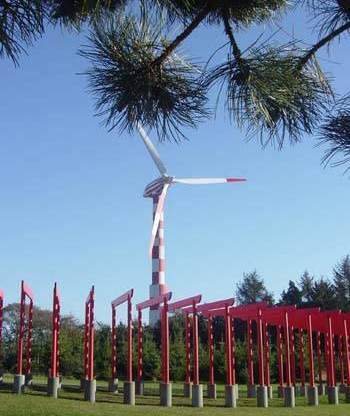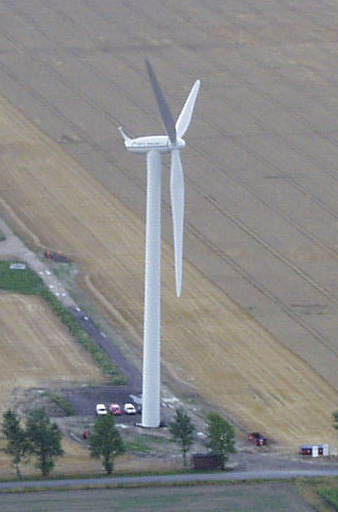by Nick Gier
Danish Social Democracy and “The Third Way” PDF
A Denmark Retrospective: Fond Memories for Me and
41 Years of Socio-Economic Progress for the Danes PDF
By Nick Gier, Professor Emeritus, University of Idahonickgier∂adelphia.net">(ngier006∂gmail.com)
When I used to drive Interstate 10 over San Gorgonio Pass to visit my parents in Palm Springs, I was always thrilled to see the 4,000 windmills on each side of the freeway. Currently they have a 565 MW capacity, and until I did the research for this column, I did not realize that most of these wind turbines came from Denmark, which now exports half the wind turbines in the world.
Denmark generates on average 20 percent of its electricity from wind, and on a really stormy day, the power produced exceeds the needs of this country of 5.5 million people. Dramatic improvement in efficiency and durability mean more energy and shut downs only in extreme conditions.

When in Denmark for my first sabbatical there in 1978-79, I was following the news about a hippie commune in Tvind that was selling excess electricity from its home-made windmill. With advice from the Danish Technical University and an engineer in Germany, the Tvind windmillers solved basic problems with rotor composition that had stumped other engineers. (The Tvind Mill is above left.)
Today over 80 percent of Danish wind mills are owned by cooperatives or individual farmers. Substantial tax credits were required to get this industry off the ground, but this government support has paid off in spades. Danish wind technology now accounts for $7.4 billion of the country’s exports, joining dairy, pork, and shipping as a major industry.
World-wide the wind industry has been growing 30 percent per year for the last 10 years, constantly outpacing its own projections. The EU countries met their own goal of 40,000 MW five years early. The U.S. has also increased its wind energy capacity (27 percent in 2006), and for the first time Texas produces more wind power than California. Wind is still only one percent of America’s total energy output.
The American wind industry has been frustrated by lack of support from the Bush administration, which is slavishly committed to petroleum rather than alternate energy sources. The Republican Congress allowed the Production Tax Credit for renewable energy to expire at the end of 2003. The result was that only 389 MW of wind power was added in 2004, making it very difficult for wind and solar investors to proceed.
On April 10, 2008, by a vote of 88 to 8, the Senate passed an energy bill that includes a 2 cent per kilowatt tax credit for renewal energy production that will last 10 years. This bill now goes to the House where it should also pass.
A recent federal study estimated that by 2030 the U.S. wind industry should be producing 300,000 MW at 6-8.5 cents/kwh with no subsidies. By contrast the report calculated that new nuclear power plants would cost 15 cents/kwh.
This is still only 20 percent of projected energy needs, a level that Denmark achieved in 2007. This is embarrassing given the fact that we could have bought the technology from Denmark 30 years at ago at a much lower cost and eliminated billions of tons of greenhouse gases as a result.
The main criticism of wind and solar power is that they depend on the sun shining and the wind blowing. Danish engineers have met this objection in creative ways. On the Danish island of Lolland, wind mills are producing 50 percent more power than the people consume, so the Lollanders are electrolyzing water to produce oxygen, which is used to speed up sewage treatment, and hydrogen, a form of energy that can be stored. Wind and solar energy can also be stored in batteries and as compressed air to run electric power turbines.
Paul La Cour (1846-1908), a Danish meteorologist, used his wind mills to produce hydrogen to fuel the lights at Askov Folk High School. (Some of the lamps blew up because there was still a little oxygen left in the hydrogen!) La Cour published The Journal of Wind Electricity and under his leadership wind power produced 3 percent of Denmark’s electricity by 1918.
Electricity can be transmitted over long distances much more efficiently as DC current. A DC grid is now in place in Scandinavia, Northern Germany, and the Netherlands, with plans to expand it across the North Sea to Scotland. (AC current cannot be transmitted under water.) The wind will always be blowing hard somewhere in this region. A similar grid in North America could send surplus wind power wherever it is needed. GE is currently planning a wind powered DC grid in Hawaii that will produce 30 percent of the islands’ energy needs.
A recent editorial in the Wall Street Journal (5-12-08) claimed that nuclear power should be favored over wind and solar because the federal subsidies per megawatt hour are $1.59, $23.37, and $24.34 respectively. Writing for Grist (5-16-08) a skeptical Charles Komanoff came up with some very different figures. Using government data, Komanoff calculated that nuclear reactor subsidies totaled $154 billion from 1950-1990, or $3.75 billion per year. When Komanoff added up all subsides for wind and solar from 1983-2007, the result was $150 million per year with a serendipitous 25-year total of $3.75 billion.
I did some of my own cost calculations for a coal-fired plant in Georgia, a nuclear reactor in Ontario, and a wind farm in Colorado. The latter would produce 8,000 MW at a cost of $14.5 billion; the nuke plant would cost $8-15 billion giving 3,500 MW; and the $2 billion Longleaf coal-fired plant would generate 1,200 MW of electricity plus 8-9 million tons of CO2 each year.
The nuclear option is the most expensive. Using $8 billion as the building cost, $2.29 million would be the cost per megawatt, while coal’s $1.7 million edges out wind’s $1.8 million per megawatt. (The cost of taking care of the nuclear waste is not included, and the U.S. is now 20 years behind schedule in this regard.) The CO2 emissions of Longleaf, the equivalent of putting 1.2 million additional cars on the road, have to be added to the equation. At $30 per ton, the carbon tax–both Obama and McCain support it–on this plant alone would be $230 million a year.

I returned to Denmark in September, 2007, my first time in 21 years after my second sabbatical there. Coming upon the new 2 MW wind mills in the countryside is an awe-inspiring experience. The 3-blade rotors are 236 feet in diameter and they sit on towers 222 feet high. Some people find windmills unsightly and don’t want them in their backyards, but I join many others in praising them as a beautiful combination of form and function. The fact that it is nonpolluting, renewable energy also adds to the pleasure. (A 2 MW Danish windmill on the left.)
Solar and wind will not be the solution for many places in the world, but together these two green energy options will help the world face the challenge of global warming and offer alternatives to the oil being produced by too many unstable countries.